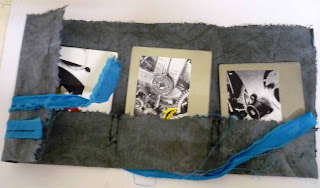 Futur Anterieur. F'nL. Photograph: Julie Clarke, 2010
Futur Anterieur. F'nL. Photograph: Julie Clarke, 2010
What would you make of an artwork entitled 'frank'scunt'? A book with a cover made from recycled materials - a piece of heavy iron (almost rusty) cut into an irregular shape, the points so sharp you'd be scared of being pierced. A 2cm wide piece of soft black leather and thin leather strap - a reference no doubt to S & M - fetish culture - bondage - skin. Inside the book several 2 X 2.5 cm close-up colour and B&W images of genital piercings - large silver rings enhanced with a bauble entwined with pubic hair and soft flesh. Pages with texts such as, 'I looove Paris in the winteer...' and 'Wearing crotchless trousers, a black leather bikey jacket, toting a machine gun, sitting then standing, then sitting again...', a page with a reference to the performance artist Marina Abromovic and Egon Schiele - artists who produced art works with or about the body.
I'm talking about an artwork produced in 2006 by Melbourne artists F''nL (Francis and Leonie Osowski) who Warren Burt referred to as 'brilliant collage artists and concrete poets', indeed he said 'I consider their 1999 'Almost Stalingrad' to be a masterpiece' (Warren Burt, 1999)1. How can Frank have a cunt - this vulgar term, which refers to the female genitalia - through body transforming technology to create the transgender, or purely in the imagination? I understand 'frank'scunt' to be an inversion, a series of images in which the female body represents Frank's queerness, the imaginary body schema located within his 'other'. And it's not a welcoming place. The cover, protecting the soft interior threatens to hurt you - is this another kind of 'vagina dentata'?
Frank and Leonie have produced many artworks over the years, most are held in the State Library of Victoria. I have about a dozen of them. What I find aesthetically pleasing about the artworks, apart from their political content is the tactile nature of the materials. Rarely soft, the covers of their hand made books are made from steel, aluminum, calico or cardboard. Once I turned the cover of one of F'nL's books and cut my finger on barbed wire or was it a piece of cyclone fence? I was worried that my blood would be seen by the bookshop owner, then realised that Frank and Leonie would have loved that the book had such a physical impact on one of its viewers. I'm not sure what the cover was made of, for they often use car parts, bits of scrap metal left on the road, old micro-wave ovens or car doors.
Although there is a alternative undercurrent to many of the artworks, most are born out of F'nL's limited study of particular works by theorists such as Foucault, Deleuze & Guattari, Heidegger, Derrida, Bataille. Indeed, their Zo: Oculus 2003 is a homage of sorts to Bataille's 'Story of the Eye' and its references to fetish and religion. The soft-canvas book includes black and white photocopied images collaged onto white paper. In each, one single eye is held up against fragmented images of a church. Zo, plays between two words Zo (people) and Zoo (animals) - control and chaos. Their nod to Henri Bergson, time and intentionality is evident in Futur antérieur, a blue-tinted canvas covered book containing three compartments that contain recycled car panels and collaged paper. The images on each card-sized element alludes to the machine parts of clocks. Perhaps obvious, perhaps not, for these images of component parts are overlaid with a bird, a woman holding an umbrella and a pattern of color.
The texts are not easy to read but this is not important, for the pleasure is in the looking - unfolding the book cover, examining the contents - a kind of scopophilia - a sensual experience, one that is ultimately personal, for the books (at least the ones that I have) are quite small and easily held. It's in this way that F'nL invite an intimacy that you cannot find when viewing artwork in a gallery or just simply looking at something on the wall. Unlike Warren Burt, I don't see these artworks as 'avant guard. They follow a tradition set by artists such as Piero Manzoni, Richard Serra, Joseph Beuys and Robert Rauschenberg, all used found objects, all placed an emphasis on the uber presence of materiality. The artist books made by F'nL are engaging and very post-modern queer!
1. Burt Warren (1999). What Does It Mean To Be Avant-Garde in the Early 21st Century? Or,Avant-Gardening in November 1999.
For Nicholas Zurbrugg. The Australian Art Design Project



No comments:
Post a Comment